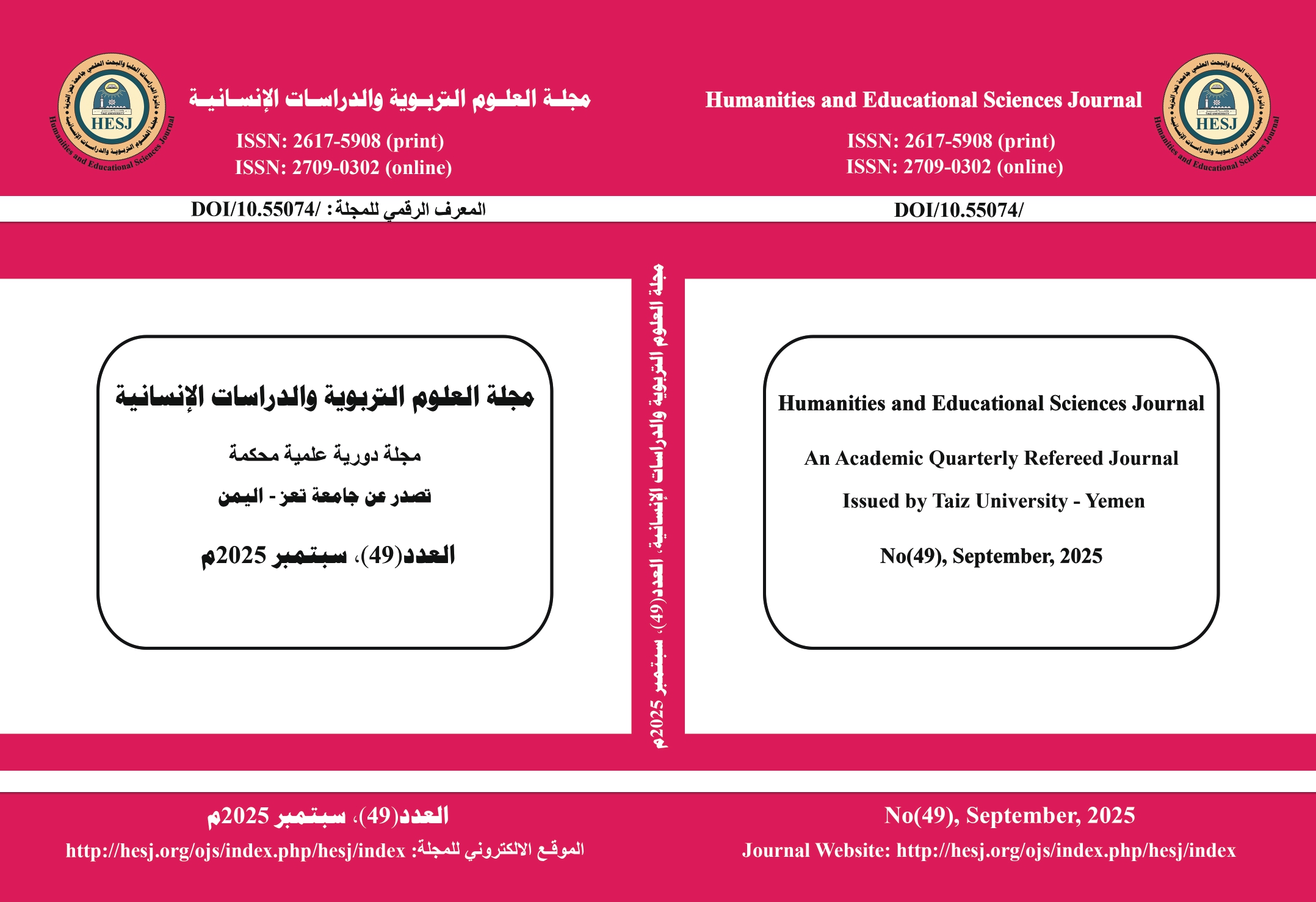Voices of Resilience: Women’s Representation in Arabic and English Literature by Female Writers and Translators
DOI:
https://doi.org/10.55074/hesj.vi49.1569الكلمات المفتاحية:
Women's representations، Cultural background، Fairclough's analysis، Translation process، Flotow's strategies، Discrimination، Visibilityالملخص
This study explores the representation of women in Arabic and English literature by female writers and examines whether this representation carries into translated works. First, it analyzes the linguistic choices female writers make to portray women and their experiences across Eastern and Western contexts, using Fairclough’s three-dimensional analysis (2013). Second, it assesses the preservation of these representations in translation, employing Flotow’s strategies (2011). The study uses two original poems from different cultural backgrounds, Arabic and English, along with their translated versions, all of which are translated by women. The findings indicate that the Arabic female writer dedicates significant effort to portraying women as victims in unforgiving societies, while the English female writer portrays women as more determined despite facing discrimination and obstacles. These portrayals reflect the respective societies in which the writers live. Moreover, the study reveals that these representations are not lost in translation, as female translators make linguistic choices to convey the essence of the original, thereby ensuring the visibility of women in the translated texts.المراجع
Alsharekh, A. (2015). Gender, translation, and the Arab renaissance: Three Wwomen writers. Feminist Studies in English Literature, 23(1), 187-207.
Achugar, M. (2017). Critical discourse analysis and history. In The Routledge handbook of critical discourse studies (pp. 298-311). Routledge.
Alramadan, N. (2017). The image of women in Arabic literature: A comparative study of novels and their English translations. Translation Studies, 10(2), 113-129.
Alsharekh, A. (2015). Translating feminism in the Arab and India. Women's Study and Research Center.
Blommaert, J., & Bulcaen, C. (2000). Critical discourse analysis. Annual review of Anthropology, 29(1), 447-466.
Caldas-Coulthard, C. R., & Coulthard, M. (Eds.). (1996). Texts and practices: Readings in critical discourse analysis. Psychology Press.
Carvalho, A. (2008). Media (ted) discourse and society: Rethinking the framework of critical discourse analysis. Journalism studies, 9(2), 161-177.
Chamberlain, L. (1988). Gender and metaphoric of translation. Signs, 13(3), 454-472.
Chidiac, P. (2016). The representation of women in translation: The case of US advertisements translated into Arabic. Perspectives: Studies in Translation Theory and Practice, 24(4), 618-632.
Dijk, T. A. (1993). Principles of critical discourse analysis. Discourse & society, 4(2), 249-283.
Dijk, T. A. (1995). Aims of critical discourse analysis. Japanese discourse, 1(1), 17-28.
Dijk, T. A. (2008). Discourse and racism. A companion to racial and ethnic studies, 145-159.
Dijk, T. A. (2015). Critical discourse analysis. The handbook of discourse analysis, 466-485.
Fairclough, N. (1992). Intertextuality in critical discourse analysis. Linguistics and education, 4 (3), 269-93.
Fairclough, N. (2013). Critical discourse analysis. In The Routledge handbook of discourse analysis (pp. 9-20). Routledge.
Fairclough, N. (2023). Critical discourse analysis. In The Routledge Handbook of Discourse Analysis (pp. 11-22). Routledge.
Flotwo, L. (2011b). Translation and gender: Translating in the 'era of feminism. University of Ottawa Press.
Godard, B. (1994). [Review of A Different Point of View: Sara Jeannette Duncan; The Dominion of Women: The Personal and the Political in Canadian Women’s Literature; Writing in the Father’s House: The Emergence of the Feminine in the Quebec Literary Tradition, by M. Dean, W. Fraser, & P. Smart]. Signs, 19(3), 835–839.
Gomaa, H., & Raymond, S. (2017). Translating violence, Misogyny, and religious fanaticism: A study of translated Arabic novels into English. Perspectives: Studies in Translation Theory and Practice, 25(1), 112-127.
Hou, Y., Sun, Y., & Li, B. (2020). A comparative study of two Chinese versions of Emma: An analysis of the application of feminist translation strategies. Perspectives: Studies in Translation Theory and Practice, 28(5), 736-754.
Huckin, T. (2002). Critical discourse analysis and the discourse of condescension. Discourse studies in composition, 155, 176.
Jan, H (2018). Texts between two cultures: Challenges of cross- cultural translation in the Arabic versions of Jane Eyre and Frankenstein [PhD Thesis, University of Northampton].
Kamal, H (2012). Travelling concepts' in translation: Feminism and gender in the Egyptian context. Literary and Translation Studies.
Kress, G. (1990). Critical discourse analysis. Annual review of applied linguistics, 11(4), 84-99.
Le, T., & Lê, Q. (2009). Critical discourse analysis: An overview. University Of Tasmania.
Li, X. (2020). Translator subjectivity from the perspective of feminist translation theory. Chinese Translators Journal, 41(2), 30-35.
Liu, K., & Guo, F. (2016). A review on critical discourse analysis. Theory and Practice in Language Studies, 6(5), 10-76.
Mohammed, M. (2017). Impact of media representation in negotiating the status of Yemeni women: A critical study of selected newspapers [ MA Thesis, Taiz University].
Musolff, A. (2012). The study of metaphor as part of critical discourse analysis. Critical discourse studies, 9(3), 301-310.
Raymond, Ch & Gomaa, S (2012). Lost in non- translation: Politics of misrepresenting Arabs.
Simon, S. (1996). Gender in translation: Cultural identity and the politics of transmission. Rutledge.
Van Leeuwen, T. (2008). Discourse and practice: New tools for critical discourse analysis. Oxford University Press.
Van Leeuwen, T. (2009). Critical discourse analysis. Discourse, of course: An overview of research in discourse studies, 277-292.
Weiss, G., & Wodak, R. (Eds.). (2007). Critical discourse analysis. Palgrave Macmillan.
Wodak, R. (2002). Aspects of critical discourse analysis. Zeitschrift für angewandte Linguistik, 36(10), 5-31.
Wodak, R. (2011). Critical linguistics and critical discourse analysis. Discursive pragmatics, 8(1), 50-70.
Wodak, R. (2014). Critical discourse analysis. In The Routledge companion to English studies (pp. 302-316). Routledge.
Wodak, R., & Meyer, M. (2009). Critical discourse analysis: History, agenda, theory and methodology. Methods of Critical Discourse Analysis, 2, 1-33.
Wodak, R., & Meyer, M. (Eds.). (2015). Methods of critical discourse studies. Sage Publication.
















